
Leucopogon juniperinus, commonly known as prickly beard-heath, is a species of flowering plant in the heath family Ericaceae and is endemic to south-eastern continental Australia. It is an erect, densely-branched shrub with oblong to more or less egg-shaped leaves with the narrower end towards the base, and white, tube-shaped flowers arranged singly in upper leaf axils.
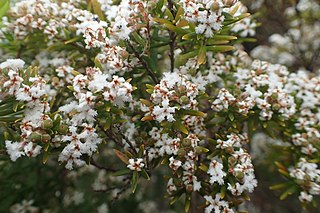
Leucopogon rubricaulis is a species of flowering plant in the heath family Ericaceae and is endemic to the south of Western Australia. It is an erect, open shrub with narrowly egg-shaped or narrowly elliptic leaves and white, tube-shaped flowers arranged on the ends of branches and in upper leaf axils in groups of four to thirteen.

Leucopogon obovatus is a species of flowering plant in the heath family Ericaceae and is endemic to the southwest of Western Australia. It is an erect shrub with hairy young branchlets, variably-shaped, simple leaves, and erect clusters of 3 to 15 white, bell-shaped flowers on the ends of branches and in upper leaf axils.
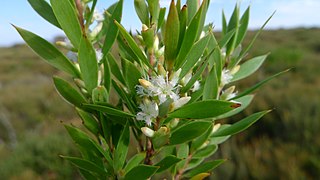
Leucopogon esquamatus, commonly known as the swamp beard-heath, is a species of flowering plant in the heath family Ericaceae and is endemic to south-eastern Australia. It is a slender shrub with mainly elliptic leaves, and short-lived white, tube-shaped flowers arranged singly or in pairs in upper leaf axils.

Leucopogon gracilis is a species of flowering plant in the heath family Ericaceae and is endemic to the south of Western Australia. It is a spindly shrub with wiry branchlets, linear to lance-shaped leaves, and dense spikes of white or pinkish flowers.

Leucopogon muticus, commonly knwon as blunt beard-heath, is a species of flowering plant in the heath family Ericaceae and is endemic to eastern Australia. It is an erect, straggling shrub with egg-shaped leaves with the narrower end towards the base, and small numbers of white, tube-shaped flowers that are densely bearded inside.

Leucopogon acuminatus is a species of flowering plant in the heath family Ericaceae and is endemic to the Northern Territory. It is a compact, erect shrub with narrowly elliptic or lance-shaped leaves and small groups of white or cream-coloured flowers.

Leucopogon australis, commonly known as spiked beard-heath, is a species of flowering plant in the heath family Ericaceae and is endemic to southern Australia. It is an erect, aromatic shrub with narrowly egg-shaped to narrowly elliptic leaves, and white flowers arranged in spikes near the ends of branchlets.

Leucopogon collinus, commonly known as fringed beard-heath, is a species of flowering plant in the heath family Ericaceae and is endemic to south-eastern Australia. It is a slender, erect or spreading shrub with narrowly lance-shaped leaves, and white, tube-shaped, bearded flowers.

Leucopogon cuspidatus is a species of flowering plant in the family Ericaceae and is endemic to the central Queensland coast. It is a shrub with densely hairy young branchlets, egg-shaped to lance-shaped leaves with the narrower end towards the base, and white, bell-shaped flowers that are bearded inside.

Leucopogon deformis is a species of flowering plant in the heath family Ericaceae and is endemic to eastern coastal Australia. It is a bushy shrub with narrowly egg-shaped leaves, and white, tube-shaped flowers.

Leucopogon glabellus is a species of flowering plant in the family Ericaceae and is endemic to the south-west of Western Australia. It is an erect, glabrous shrub with slender branchlets, heart-shaped to lance-shaped leaves, and cylindrical spikes of white flowers.

Leucopogon interruptus is a species of flowering plant in the family Ericaceae and is endemic to the southwest of Western Australia. It is a spreading, glabrous shrub with oval to oblong leaves crowded at the ends of branches, and many small, white, tube-shaped flowers that are bearded inside.

Leucopogon margarodes is a species of flowering plant in the heath family Ericaceae and is endemic to near-coastal areas of eastern Australia. It is an erect, spreading shrub with egg-shaped leaves with the narrower end towards the base, and small numbers of white, tube-shaped flowers usually arranged singly or in pairs in upper leaf axils.
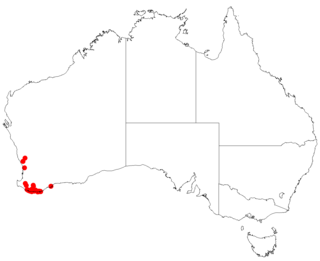
Leucopogon polystachyus is a species of flowering plant in the heath family Ericaceae and is endemic to the south-west of Western Australia. It is a slender, erect, usually glabrous shrub that typically grows to a height of 0.4–2 m. Its leaves are linear to lance-shaped, 8.5–17 mm (0.33–0.67 in) long with a rigid, sharply-pointed tip on the end. The flowers are borne on the ends of branches or in leaf axils in short, dense spikes with small, egg-shaped bracts and bracteoles about half as long as the sepals. The sepals are about 3.2 mm (0.13 in) long and often pale pink, and the petals are white, about 4 mm (0.16 in) long and joined at the base, forming a tube, the petal lobes longer than the petal tube.

Leucopogon reflexus, commonly known as heart-leaf beard-heath, is a species of flowering plant in the heath family Ericaceae and is endemic to the south-west of Western Australia. It is an erect shrub with small, usually downturned leaves and short, dense spikes of tube-shaped, white flowers.

Leucopogon rotundifolius is a species of flowering plant in the heath family Ericaceae and is endemic to the south of Western Australia. It is an erect, bushy shrub with round or egg-shaped leaves, the narrower end towards the base, and white, tube-shaped flowers arranged in leaf axils in groups of 2 or 3.
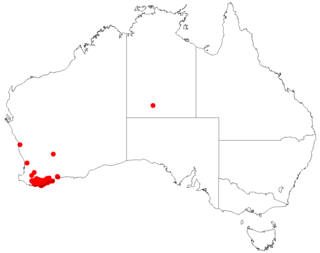
Leucopogon tamariscinus is a species of flowering plant in the heath family Ericaceae and is endemic to the south of Western Australia. It is an erect shrub with egg-shaped or lance-shaped leaves and white, tube-shaped flowers arranged in dense spikes on the ends of branches.

Leucopogon virgatus, commonly known as common beard-heath, is a species of flowering plant in the heath family Ericaceae and is endemic to south-eastern Australia. It is an erect to low-lying shrub with linear to narrowly lance-shaped or egg-shaped leaves, and erect clusters of three to seven white, tube-shaped flowers on the ends of branches and in upper leaf axils.
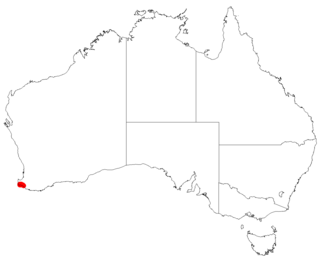
Leucopogon wheelerae is a species of flowering plant in the heath family Ericaceae and is endemic to the far south-west of Western Australia. It is a sprawling shrub with slender, glabrous young branchlets, more or less erect, egg-shaped or broadly egg-shaped leaves, and white, broadly bell-shaped flowers with white or pale pink lobes.





















